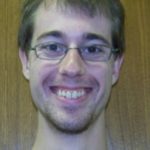Kyle Harrison
(Former NSF-REU)
University of Nebraska
kyle.harrison@huskers.unl.edu
Kyle participated in a collaborative study between Raul F. Medina (Texas A&M University), Cesar Rodriguez-Saona (Rutgers University) and Zsofia Szendrei (Michigan State Univeristy) laboratories. He explored if there was hos-associated differentiation in the cranberry fruitworm, Acrobasis vaccinii Riley (Lepidoptera: Pyralidae). Host-associated differentiation (HAD) is a mechanism promoting species diversity by genetically isolating subpopulations within a species adapting to new host species. The cranberry fruitworm has co-evolved with both cranberries and blueberries for millennia in its native habitat. If HAD is a common phenomena in nature, it is likely to be found in such a system. Kyle tested the cranberry fruitworm for HAD by examining the genetic fingerprint of individuals associated with cranberry compared to those living on blueberry. Kyle worked with samples from blueberries and cranberries collected by Rdriguez Saona and Szendrei throughout various farms across New Jersey. Amplified fragment length polymorphism (AFLP) markers were developed by Kyle to assess the existence of HAD. Kyle found that even though theory would predict HAD on the cranberry fruitworm, no HAD in fruitworms associated with blueberries and cranberries was present. Kyle presented his results at the Entomological Society of America meeting in Reno in 2008.
Melaina Macone
(Former NSF-REU)
Sweet Briar College
macone11@sbc.edu
Melaina participated in a collaborative study between Raul F. Medina (Texas A&M University) and Saskya Van Nouhuys (Cornell University) laboratories. Melaina studied the population genetics of two parasitoids of the Glanville fritillary butterfly, Melitaea cinxia (Lepidoptera: Nymphalidae). This species is native to the Åland Islands in Finland and is the only known host for the specialist parasitoid, Hyposoter horticola (Hymenoptera: Ichneumonidae). H. horticola has a relatively high dispersal rate (dispersing >5 km while seeking hosts). Because H. horticola has a relatively high rate of dispersal, the Åland Islands are experienced as a single fragmented habitat. H. horticola is host to the endoparasitic hyperparasitoid Mesochorus sp. cf. stigmaticus (Hymenoptera: Ichneumonidae). M. stigmaticus is also able to hyperparasitize Cotesia melitaearum (Hymenoptera: Braconidae), the competitor of H. horticola. In her study Melaina investigated the population structure of H. horticola and M. stigmaticus based on their geographic distribution throughout the Åland Islands using AFLP markers. Melaina was scheduled to present her results at the Entomological Society of America meeting in Indianapolis in 2009, however the snow storms that year prevented her from reaching the meeting in time. Nevertheless, she presented her results at the MARCUS conference in Sweet Briar College, Virginia.
Luke Henry
Former NSF_REU
Bard College
lh386@bard.edu
Luke participated in a collaborative effort between Thom De Witt lab and mine. He examined morphological differentiation in the cotton fleahopper (Pseudatomoscelis seriatus) on two of its host plant species at two sites that differ in their in the presence of host associated differenitation (HAD). An ensemble of morphological traits were measured and compared between P. seriatus from cotton and horsemint at two selected sites. He found that host-plant species affects P. seriatus morphology regardless of the presence of HAD. Our findings suggest that cotton and horsemint inflict different selective pressures on P. seriatus resulting in differing phenotypes that may allow P. seriatus to better exploit their host plants. Luke will present his results at the Entomological Society of America Annual Meeting in San Diego this year.

